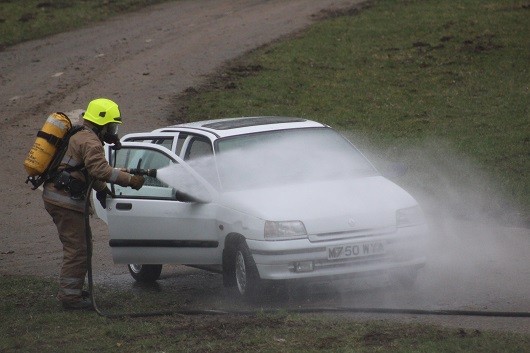A leading newspaper recently reported a perhaps peculiar headline recently, having covered a story about Blair Drummond safari park in Scotland staging a car fire scenario in its lion enclosure. It peaked our interest at Tecserv UK because it served as a really good reminder to all businesses as to why and how you should practice a fire drill, and that you should also practice unusual scenarios – however unlikely it may be that they will happen.
The fire drill at Blair Drummond was a controlled fire drill and was intended to test both the staff and emergency response to the scenario. It was staged ahead of the re-opening of the park for summer, and in our opinion, is an excellent example of best practice.

Photo courtesy of Blair Drummond Safari Park
So, on to the question, why and how you should practice a fire drill.
Why businesses should practice a fire drill
The why is self evident. Firstly it is a legal obligation for all businesses to ensure they have a documented fire evacuation procedure, and secondly a well practiced fire drill will help save lives!
It is best practice to ensure the fire drill is routinely carried out at regular intervals (at least annually) so that all staff know what is expected of them and can recognise the audible and visual sounds their fire alarm system will emit if a emergency evacuation is required. Most businesses will run a pre announced ‘test’ of its fire alarm at a specific time, on a specific day to ensure it works and staff have a chance to remind themselves of the sounds and the evacuation procedure.
Like the Safari park example, if there are scenarios and fire risks that are likely, though unusual, within your business they should also be practiced as part of the fire drill routine.
You should also remember to train new staff when they start work and tell all employees about any new fire risks.
How to practice your fire drill
Legally, you should carry out at least one fire drill per year and record the results. You must keep the results as part of your fire safety and evacuation plan.
As part of the role of a responsible person, this person, or team of people will need to carry out regular checks to make sure that:
As part of this process the responsible individual will also ensure that the procedures laid down in the company fire evacuation policy are actioned.
This plan must include the following and also take into account the needs of people who may have mobility issues:
It is important to ensure all staff are trained on the importance of the above fire safety measures and are fully aware of what they must do and where they should assemble in the event of a fire.
Once at the safe meeting point a register should be called to ensure everyone is present or there whereabouts is accounted for. This is why it is important to have a suitable access control system or process and ensure visitors are recorded accurately.
Fire drills are critical for ensuring the safety of the employees and visitors to your businesses builds and properties. Practicing scheduled fire drills will help ensure individuals have the knowledge to safely escape a fire without injuring themselves or others.
If you would like further advice or information about protecting your people, processes and property please contact us or complete the enquiry form.

Neil has held a variety of positions in sales, technical and management since he started in the fire and security industry in 1989. Over this time he has amassed a tremendous amount of experience from working for both large and niche players.